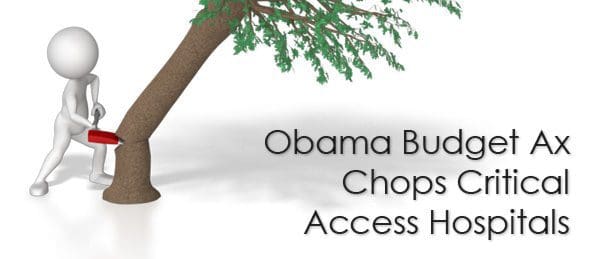Call us toll-free: 800-878-7828 — Monday - Friday — 8AM - 5PM EST

While everyone is affected by the proposed cuts, they are particularly painful for smaller hospitals, which have tighter margins and fewer options for dropping services or making up the losses.
By John Commins, for HealthLeaders Media
The Obama Administration’s 2016 budget axe takes a double whack at critical access hospitals.
First, the proposal eliminates critical access designation for hospitals closer than 10 miles from the nearest hospital, which would create projected savings of $770 million.
Second, critical access hospitals that are fortunate enough to maintain that designation will see their reimbursements cut from 101% to 100% of costs, which is expected to save the federal government about $1.7 billion over the next decade.
The National Rural Health Association, in Washington, DC, this week for its 26th annual Rural Health Policy Institute, calls the president’s proposal “short-sighted.”
“Rural hospitals already operate at the narrowest of financial margins—41% already operate at a loss,” NRHA lead lobbyist Maggie Elehwany told me by email.
Rural hospitals aren’t the only providers targeted for cuts in the 2016 budget. Hospitals in general don’t fare well under the Obama spending plan. The American Hospital Association and America’s Essential Hospitals earlier this week blasted the budget plan for a broad array of cuts.
While everyone is affected, these cuts are particularly painful for smaller hospitals because they have much smaller margins and fewer places where they can cut services or make up the losses.
“Sequestration, DSH, bad debt, and other types of cuts have already hit rural hospitals hard,” Elehwany says. “Forty-seven rural hospitals have closed since 2010, and 283 more are on the verge of closure. If this occurs, 700,000 rural patients will be without access to their closest point of emergency care. We hope that the President will recognize the importance of critical access hospitals and stop calling for cuts to these important facilities.”
Making matters worse, Elehwany says, the 2016 budget again “zeroed out” funding for Area Health Education Centers, which provide recruiting and training for rural medical staff.
“Over 90% of the rural counties in this nation are Health Professional Shortage Areas,” Elehwany says. “AHECs do much to improve workforce shortages where the need is the greatest—rural America.”
The wisdom of these budget cuts can be questioned, but nobody paying attention should be surprised. We all saw this coming. The Obama Administration and the federal government have for several years made it clear that they will closely examine the critical access hospital sector to see what savings can be wringed from it.
In August 2013, a report from the Office of the Inspector General for the Department of Health and Human Services recommended that Congress allow the Centers for Medicare & Medicaid Services to strip critical access designation from the nearly 1,000 hospitals with “permanent exemption” status under a state “necessary provider” designation.
OIG refloated the idea last August in a related report detailing the higher costs that Medicare beneficiaries pay for outpatient services at critical access hospitals, when compared with the same services at acute care hospitals.
Before we rush to the fire escape, let’s put some perspective on this. First, Republicans now control the House and Senate, and GOP lawmakers in both chambers have declared the Obama budget DOA.
Second, rural health is a true bipartisan issue. A good number of Republicans and Democrats represent rural states. Leaders in both parties understand the importance of properly funding rural healthcare. They understand that rural hospitals are economic engines for their regions, and they understand that access to healthcare is a critical issue for their constituents, the voters.
Nothing is guaranteed when it comes to Congress. (Remember how they knee-capped ICD-10 last year!) With the new fiscal year, however, I cannot imagine that Republican majorities would agree to the president’s call to end non-defense sequestrations and turn around and cut funding for rural hospitals.
Near term, it would be surprising to see critical access hospitals lose their designation or their funding.
That doesn’t mean that rural healthcare providers and patient advocates can relax. The president’s budget, and recommendations from OIG make it clear that the federal government has critical access hospitals in its crosshairs. This likely will continue after Obama leaves office. The pressure to find savings in a healthcare sector that consumes nearly 20 cents of every dollar spent will continue with Obama’s successor, regardless of her or his political affiliation.
Small rural hospitals are free to hope for the best, but they should also prepare for the inevitable.
